Lucie Lomová: no bounds to reality
Comic books and graphic novels are rapidly becoming a popular and
recognized form of Czech literature and they build on a tradition that in
this country goes back well over a century. Lucie Lomová is one of the
foremost representatives of the art form here and her books both for
children and adults are hugely popular. A testimony to her talent is the
fact that her books have even made an impact in France, the spiritual home
of the comic strip. She talks to David Vaughan.
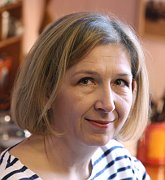 Lucie Lomová, photo: Robert Sedmík
When Lucie Lomová’s graphic novel, Divoši (The Savages) came out in
2011, it was something of a publishing sensation. With wonderful attention
to visual and historical detail, she tells the moving and true story of the
Paraguayan Indian, Čerwuiš, who was brought to Prague at the beginning of
the 20th century and held up a mirror to our European civilization. This
book, possibly more than any other helped to make the graphic novel part of
the Czech literary mainstream, and it is just one of a several books for
adults that Lucie Lomová has published over the last few years. She has
been just as successful with her comic strips for children, which have kept
their appeal even in the age of the iPhone and laptop. I asked Lucie where
it all began and she went back to her childhood in the late 1960s.
Lucie Lomová, photo: Robert Sedmík
When Lucie Lomová’s graphic novel, Divoši (The Savages) came out in
2011, it was something of a publishing sensation. With wonderful attention
to visual and historical detail, she tells the moving and true story of the
Paraguayan Indian, Čerwuiš, who was brought to Prague at the beginning of
the 20th century and held up a mirror to our European civilization. This
book, possibly more than any other helped to make the graphic novel part of
the Czech literary mainstream, and it is just one of a several books for
adults that Lucie Lomová has published over the last few years. She has
been just as successful with her comic strips for children, which have kept
their appeal even in the age of the iPhone and laptop. I asked Lucie where
it all began and she went back to her childhood in the late 1960s.
“We were in Chicago in America with my parents because my father was working at the university there. I was going to kindergarten and we were drawing pictures. I drew a picture with a magic carpet and I was sitting on that carpet. And the text under the carpet was: ‘I’m going to visit my three grandmothers in Prague.’ The teacher was a little bit upset because she thought I didn’t speak English. She insisted on two grandmothers, but I insisted on three because my great-grandmother was included. So I remember this. Much later, when I made the book ‘Anna Wants to Jump’ there is a cover picture where Anna is flying in the air among the clouds, and this reminded me of the first image I remember, because it’s the same idea – that she wants to fly somewhere else.”
And do you think that the fact that you spent part of your childhood abroad in America has been formative in your work as an artist and comics maker?
“Yes, definitely, because it was in 1969 to 1970 and it was the time of pop culture and it was so different from Czechoslovakia at that time that it was like switching from black-and-white TV to colour. A big influence were the American comics of the time, because I wasn’t able to read English – I wasn’t able to read at all – because I was five years old and comics are easy to understand even without words. So it was my tool, how to start reading.”
And when you came back to Czechoslovakia, it wasn’t a world completely without comics, was it?
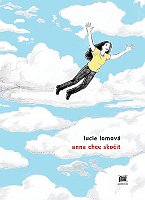 ‘Anna Wants to Jump’, photo: Meander
“No, of course it was not. I have some comics from my grandmother –
Punťa, he was a little dog, and his girlfriend, having different kinds of
adventures, and this was from the 1930s. And then there is the big
tradition of Rychlé šípy – everybody knows them and I think almost
everybody loves them. They were also my heroes…”
‘Anna Wants to Jump’, photo: Meander
“No, of course it was not. I have some comics from my grandmother –
Punťa, he was a little dog, and his girlfriend, having different kinds of
adventures, and this was from the 1930s. And then there is the big
tradition of Rychlé šípy – everybody knows them and I think almost
everybody loves them. They were also my heroes…”
They are a group of boys – the Swift Arrows – who don’t so much get up to mischief as spend their time putting things right.
“Of course, they are completely positive heroes. But they do have some funny character features.”
And when you were growing up, did you decide to study fine art?
“I was always drawing and I thought that I should learn something else. So I decided to go to the theatre academy and I thought I could be a playwright. But all the time I was drawing and I started to publish cartoons in a magazine called Dikobraz – porcupine – at the age of about eighteen.”
This was still in the communist period. Did you have a sense that you could do what you wanted or were you aware of the censorship or self-censorship that was hanging over society – because cartoons are a very subversive medium in many societies?
“Yes. Of course the Porcupine magazine was published by communists, but there were also people who were trying to push through some satirical ideas. Of course it was toothless at that time, but still it was possible to publish some cartoons that were not dealing with ideology.”
So what was the first longer comic that you did?
“Maybe it was Anča and Pepík.”
These are classic comic strip or cartoon figures – two mice having adventures – but somehow they captured people’s imagination and became extremely popular.
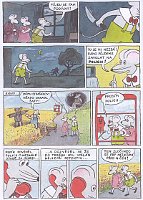 ‘Anča and Pepík’, photo: Academia
“Yes. They are almost like people. The only difference is that they have
mouse heads. It’s a bit of an old-timer world, because they have no
mobile phones or computers. They are not brother and sister but they are
friends and they live in two little houses near the wall on the edge of the
city which is called Ušín – you might call it Mousetown. Some of the
stories are fairytales, some are detective stories.”
‘Anča and Pepík’, photo: Academia
“Yes. They are almost like people. The only difference is that they have
mouse heads. It’s a bit of an old-timer world, because they have no
mobile phones or computers. They are not brother and sister but they are
friends and they live in two little houses near the wall on the edge of the
city which is called Ušín – you might call it Mousetown. Some of the
stories are fairytales, some are detective stories.”
One thing that had a major impact on you was travelling to France.
“Yes, I have a special feeling for France because my first comic books for adults were initially published in France, thanks to a series of coincidences. Since then I published all three of my books for adults there. My publisher lives in Angoulême which is a city where the most famous festival in the world takes place and the whole city lives with comics. They also have house where comics authors and animators come to. I applied there and they gave me a grant and a residency for two months.”
And France is a world power when it comes to comic strip – bandes dessinées. It must have been very stimulating for you being in that environment.
“Here there are only a few of us doing comics and in Angoulême there was a house full of about twenty people who were solving similar problems like me. So it felt like a seventh heaven.”
The graphic novel that opened the door for you to travel to France was “Anna chce skočit” (Anna wants to jump) which is not for children.
“No, it’s not for children. The story is not easy to describe because the plot is very complicated. It’s like a road movie, where the events are piling up on each other and it’s a personal story of the main character Anna who is discovering her own history and her own family history. She finds out that she has a twin sister and that her family history is very firmly bound with the history of Czechoslovakia. It’s in black-and-white and I used two graphic styles, one for dreams and for retrospectives which are very important and the simplified black-and-white shades of grey for the present.”
And I’d like to ask you about the book that came after Anna Wants to Jump, which is Divoši (The Savages). Of all your books it’s probably the one that has been most talked about and written about.
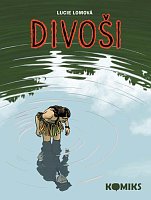 'The Savages', photo: Labyrint
“It is the story of Čerwuiš, an Indian from the Paraguayan Gran Chaco,
who was brought to Europe at the beginning of the 20th century.”
'The Savages', photo: Labyrint
“It is the story of Čerwuiš, an Indian from the Paraguayan Gran Chaco,
who was brought to Europe at the beginning of the 20th century.”
And this is a true story.
“Yes. I was fascinated by the true story. It was the reason why I chose it.”
There is a lot of attention to historical detail, which I love in the book. You really have gone out of your way to make sure that the backdrops – for example Prague at the turn of the century, are very accurate.
“I studied historical photographs a lot and I was going to museums and looking at old photographs, because the town and the society is a kind of character in this book. The story is about how the world was changing and how the new world is killing the old one. And the same process was happening in the city, because Prague at the beginning of the 20th century was a mixture of old dying houses and quarters. It was also the time when the Jewish Quarter was destroyed and new houses were built there and the whole society was very quickly changing. And I wanted to show the face of the town very precisely.”
And since the book The Savages you’ve written a detective graphic novel with a rather unusual detective in the form of an old lady investigating a murder.
“Yes, her name is Dita Oulipská and she’s a theatre critic. I loved this character because she’s not a very nice one, you know, she’s quite strict and not very polite. She doesn’t look very good, but she’s a charming personality and a very specific one. The other character is her husband, who is a detective and they together are solving the problem of who has killed an actor.”
And in this story you’ve returned to black-and-white from the colour of The Savages. It’s a kind of timeless world. It could be the present but it could also be fifty years ago.
“It’s similar to Anča and Pepík’s world because you cannot say when it takes place. Maybe it takes place in my head only. There are no bounds to reality.”
I’d like to ask you about being a graphic novelist in the Czech Republic. Do you feel that it’s understood and respected in this country?
“I think now it’s changing very much. It’s only now that different sorts of comics are appearing. It will take some time until people realize that comics are not only for teenagers but it’s a process which is very fast-moving.”
The world of comics is also quite often seen as a predominantly male world.
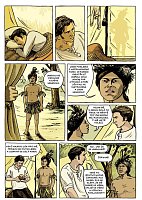 'The Savages', photo: Labyrint
“This is connected with the fact that in the mainstream comics the
majority of them are about superheroes and it’s definitely the world of
men and boys. Girls have different kinds of heroes. But now, as comics are
changing so fast, you can even find comics which are mainly for girls and I
don’t like this dividing of the audience very much, because you never
know who will be interested.”
'The Savages', photo: Labyrint
“This is connected with the fact that in the mainstream comics the
majority of them are about superheroes and it’s definitely the world of
men and boys. Girls have different kinds of heroes. But now, as comics are
changing so fast, you can even find comics which are mainly for girls and I
don’t like this dividing of the audience very much, because you never
know who will be interested.”
Where do you go from here?
“Now I am taking time out of comics because I am back at Anča and Pepík, in that I’m doing an animation series for Czech TV, which is based on several stories about Anča and Pepík.”
With an animated TV series at first sight I would think that it is very similar to what you’re doing when you do a comic strip, but it’s actually a very different skill, isn’t it?
“Comics are very different, because the reader can choose his time for reading and can skip through the pages, and this fact of space is very important. When you are watching a movie you are ordered to perceive it in specific time, which is not chosen by you. It’s as though someone is guiding you, while in comics you are your own guide.”
So you are looking forward to getting back to comics again.
“Yes, I am!”
Source:-radio.cz

No comments:
Post a Comment